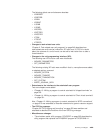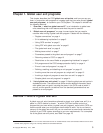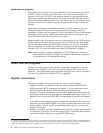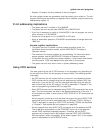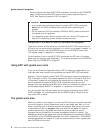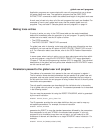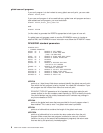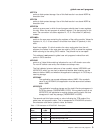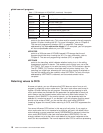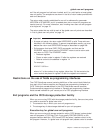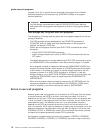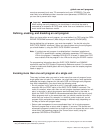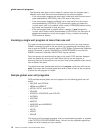Application programs can communicate with user exit programs that use or share
the same global work area. The application program uses the EXEC CICS
EXTRACT EXIT command to obtain the address and length of the global work area.
A work area is freed only when all of the exit programs that use it are disabled. For
examples of how to use a global work area, see the sample global user exit
programs. They are listed in “Sample global user exit programs” on page 14.
Making trace entries
If tracing is active, an entry in the CICS trace table can be made immediately
before and immediately after the execution of an exit program. To specify that these
entries are to be made, use the UE option of either:
v The CETR transaction
v The EXEC CICS SET TRACETYPE command.
For global user exits in domains, extra trace calls giving more information are also
available if you have set the AP option of EXEC CICS SET TRACETYPE to level 1
or 2. For information about trace entries, refer to the
CICS Problem Determination
Guide
.
In some cases, when tracing is active, you can also make trace entries from within
a user exit program, using the XPI DFHTRPTX TRACE_PUT macro described in
“Chapter 3. The user exit programming interface (XPI)” on page 283. The individual
descriptions of the global user exit points show whether the XPI DFHTRPTX macro
can be used at each point.
Parameters passed to the global user exit program
The address of a parameter list is passed to the user exit program in register 1.
The list contains some standard parameters that are passed to all global user exit
programs, and may also contain some exit-specific parameters that are unique to
the exit point from which the exit program is being invoked. Not all of the exit points
have these extra parameters.
The exit-specific parameters are described with the individual exits in the section
“List of global user exit points” on page 19. The standard parameter list is described
in the following section.
You can map the parameter list using the DSECT DFHUEPAR, which is generated
by the macro instruction
DFHUEXIT TYPE=EP,ID=exit_point_identifier
The ID parameter provides the extra data definitions that you need to map any
exit-specific parameters. For example, the macro instruction
DFHUEXIT TYPE=EP,ID=XTDIN
generates the DSECT to map the standard parameters followed by the parameters
that are specific to exit point XTDIN in the transient data program. If your exit
program is to be invoked at more than one exit point, you can code up to 256
characters of relevant exit identifiers on a single DFHUEXIT macro instruction. For
example:
DFHUEXIT TYPE=EP,ID=(XMNOUT,XSTOUT,XTDIN)
global user exit programs
Chapter 1. Global user exit programs 7



